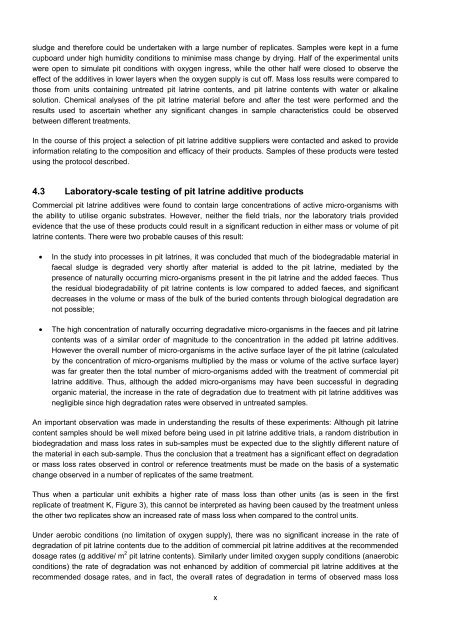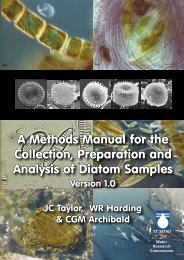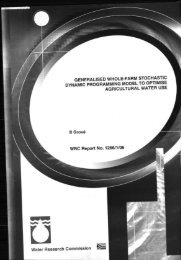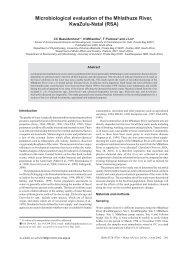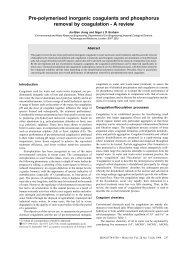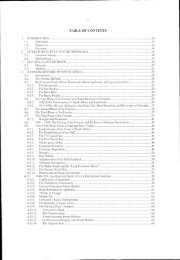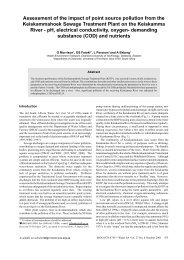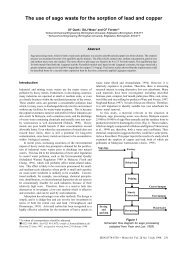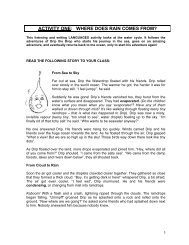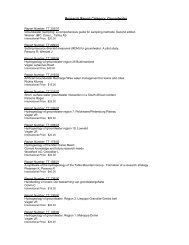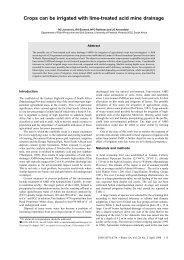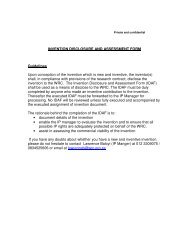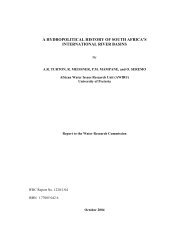and the Efficacy of Pit Latrine Additives - Water Research Commission
and the Efficacy of Pit Latrine Additives - Water Research Commission
and the Efficacy of Pit Latrine Additives - Water Research Commission
- No tags were found...
You also want an ePaper? Increase the reach of your titles
YUMPU automatically turns print PDFs into web optimized ePapers that Google loves.
sludge <strong>and</strong> <strong>the</strong>refore could be undertaken with a large number <strong>of</strong> replicates. Samples were kept in a fume<br />
cupboard under high humidity conditions to minimise mass change by drying. Half <strong>of</strong> <strong>the</strong> experimental units<br />
were open to simulate pit conditions with oxygen ingress, while <strong>the</strong> o<strong>the</strong>r half were closed to observe <strong>the</strong><br />
effect <strong>of</strong> <strong>the</strong> additives in lower layers when <strong>the</strong> oxygen supply is cut <strong>of</strong>f. Mass loss results were compared to<br />
those from units containing untreated pit latrine contents, <strong>and</strong> pit latrine contents with water or alkaline<br />
solution. Chemical analyses <strong>of</strong> <strong>the</strong> pit latrine material before <strong>and</strong> after <strong>the</strong> test were performed <strong>and</strong> <strong>the</strong><br />
results used to ascertain whe<strong>the</strong>r any significant changes in sample characteristics could be observed<br />
between different treatments.<br />
In <strong>the</strong> course <strong>of</strong> this project a selection <strong>of</strong> pit latrine additive suppliers were contacted <strong>and</strong> asked to provide<br />
information relating to <strong>the</strong> composition <strong>and</strong> efficacy <strong>of</strong> <strong>the</strong>ir products. Samples <strong>of</strong> <strong>the</strong>se products were tested<br />
using <strong>the</strong> protocol described.<br />
4.3 Laboratory-scale testing <strong>of</strong> pit latrine additive products<br />
Commercial pit latrine additives were found to contain large concentrations <strong>of</strong> active micro-organisms with<br />
<strong>the</strong> ability to utilise organic substrates. However, nei<strong>the</strong>r <strong>the</strong> field trials, nor <strong>the</strong> laboratory trials provided<br />
evidence that <strong>the</strong> use <strong>of</strong> <strong>the</strong>se products could result in a significant reduction in ei<strong>the</strong>r mass or volume <strong>of</strong> pit<br />
latrine contents. There were two probable causes <strong>of</strong> this result:<br />
<br />
<br />
In <strong>the</strong> study into processes in pit latrines, it was concluded that much <strong>of</strong> <strong>the</strong> biodegradable material in<br />
faecal sludge is degraded very shortly after material is added to <strong>the</strong> pit latrine, mediated by <strong>the</strong><br />
presence <strong>of</strong> naturally occurring micro-organisms present in <strong>the</strong> pit latrine <strong>and</strong> <strong>the</strong> added faeces. Thus<br />
<strong>the</strong> residual biodegradability <strong>of</strong> pit latrine contents is low compared to added faeces, <strong>and</strong> significant<br />
decreases in <strong>the</strong> volume or mass <strong>of</strong> <strong>the</strong> bulk <strong>of</strong> <strong>the</strong> buried contents through biological degradation are<br />
not possible;<br />
The high concentration <strong>of</strong> naturally occurring degradative micro-organisms in <strong>the</strong> faeces <strong>and</strong> pit latrine<br />
contents was <strong>of</strong> a similar order <strong>of</strong> magnitude to <strong>the</strong> concentration in <strong>the</strong> added pit latrine additives.<br />
However <strong>the</strong> overall number <strong>of</strong> micro-organisms in <strong>the</strong> active surface layer <strong>of</strong> <strong>the</strong> pit latrine (calculated<br />
by <strong>the</strong> concentration <strong>of</strong> micro-organisms multiplied by <strong>the</strong> mass or volume <strong>of</strong> <strong>the</strong> active surface layer)<br />
was far greater <strong>the</strong>n <strong>the</strong> total number <strong>of</strong> micro-organisms added with <strong>the</strong> treatment <strong>of</strong> commercial pit<br />
latrine additive. Thus, although <strong>the</strong> added micro-organisms may have been successful in degrading<br />
organic material, <strong>the</strong> increase in <strong>the</strong> rate <strong>of</strong> degradation due to treatment with pit latrine additives was<br />
negligible since high degradation rates were observed in untreated samples.<br />
An important observation was made in underst<strong>and</strong>ing <strong>the</strong> results <strong>of</strong> <strong>the</strong>se experiments: Although pit latrine<br />
content samples should be well mixed before being used in pit latrine additive trials, a r<strong>and</strong>om distribution in<br />
biodegradation <strong>and</strong> mass loss rates in sub-samples must be expected due to <strong>the</strong> slightly different nature <strong>of</strong><br />
<strong>the</strong> material in each sub-sample. Thus <strong>the</strong> conclusion that a treatment has a significant effect on degradation<br />
or mass loss rates observed in control or reference treatments must be made on <strong>the</strong> basis <strong>of</strong> a systematic<br />
change observed in a number <strong>of</strong> replicates <strong>of</strong> <strong>the</strong> same treatment.<br />
Thus when a particular unit exhibits a higher rate <strong>of</strong> mass loss than o<strong>the</strong>r units (as is seen in <strong>the</strong> first<br />
replicate <strong>of</strong> treatment K, Figure 3), this cannot be interpreted as having been caused by <strong>the</strong> treatment unless<br />
<strong>the</strong> o<strong>the</strong>r two replicates show an increased rate <strong>of</strong> mass loss when compared to <strong>the</strong> control units.<br />
Under aerobic conditions (no limitation <strong>of</strong> oxygen supply), <strong>the</strong>re was no significant increase in <strong>the</strong> rate <strong>of</strong><br />
degradation <strong>of</strong> pit latrine contents due to <strong>the</strong> addition <strong>of</strong> commercial pit latrine additives at <strong>the</strong> recommended<br />
dosage rates (g additive/ m 2 pit latrine contents). Similarly under limited oxygen supply conditions (anaerobic<br />
conditions) <strong>the</strong> rate <strong>of</strong> degradation was not enhanced by addition <strong>of</strong> commercial pit latrine additives at <strong>the</strong><br />
recommended dosage rates, <strong>and</strong> in fact, <strong>the</strong> overall rates <strong>of</strong> degradation in terms <strong>of</strong> observed mass loss<br />
x


